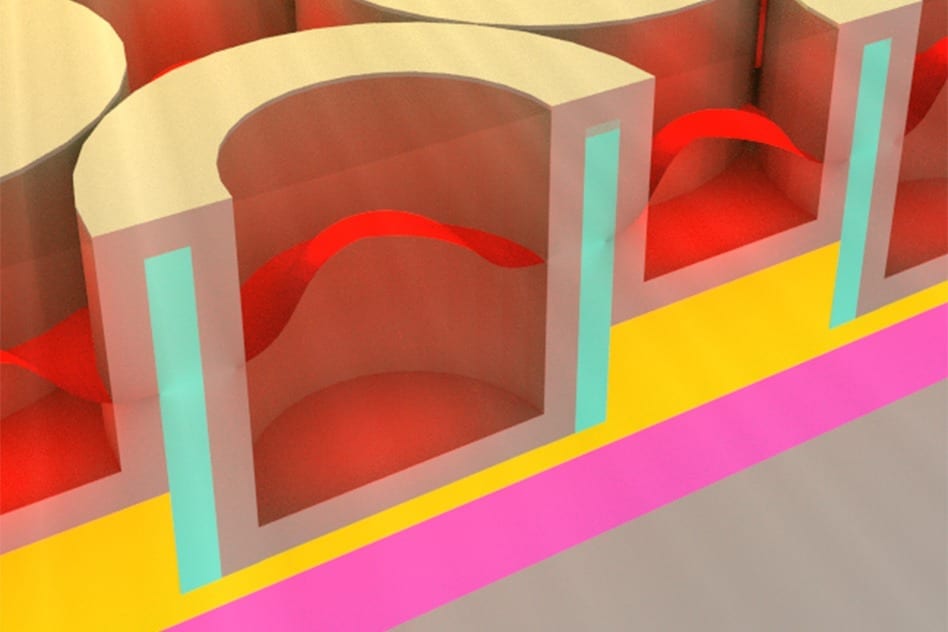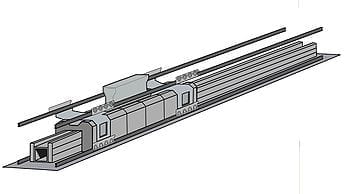
New system aims to harness the full spectrum of available solar radiation – “This is the first device that is able to do all these things at the same time”
The key to creating a material that would be ideal for converting solar energy to heat is tuning the material’s spectrum of absorption just right: It should absorb virtually all wavelengths of light that reach Earth’s surface from the sun — but not much of the rest of the spectrum, since that would increase the energy that is reradiated by the material, and thus lost to the conversion process.
Now researchers at MIT say they have accomplished the development of a material that comes very close to the “ideal” for solar absorption. The material is a two-dimensional metallic dielectric photonic crystal, and has the additional benefits of absorbing sunlight from a wide range of angles and withstanding extremely high temperatures. Perhaps most importantly, the material can also be made cheaply at large scales.
The creation of this material is described in a paper published in the journal Advanced Materials, co-authored by MIT postdoc Jeffrey Chou, professors Marin Soljacic, Nicholas Fang, Evelyn Wang, and Sang-Gook Kim, and five others.
The material works as part of a solar-thermophotovoltaic (STPV) device: The sunlight’s energy is first converted to heat, which then causes the material to glow, emitting light that can, in turn, be converted to an electric current.
Some members of the team worked on an earlier STPV device that took the form of hollow cavities, explains Chou, of MIT’s Department of Mechanical Engineering, who is the paper’s lead author. “They were empty, there was air inside,” he says. “No one had tried putting a dielectric material inside, so we tried that and saw some interesting properties.”
When harnessing solar energy, “you want to trap it and keep it there,” Chou says; getting just the right spectrum of both absorption and emission is essential to efficient STPV performance.
Most of the sun’s energy reaches us within a specific band of wavelengths, Chou explains, ranging from the ultraviolet through visible light and into the near-infrared. “It’s a very specific window that you want to absorb in,” he says. “We built this structure, and found that it had a very good absorption spectrum, just what we wanted.”
In addition, the absorption characteristics can be controlled with great precision: The material is made from a collection of nanocavities, and “you can tune the absorption just by changing the size of the nanocavities,” Chou says.
Another key characteristic of the new material, Chou says, is that it is well matched to existing manufacturing technology. “This is the first-ever device of this kind that can be fabricated with a method based on current … techniques, which means it’s able to be manufactured on silicon wafer scales,” Chou says — up to 12 inches on a side. Earlier lab demonstrations of similar systems could only produce devices a few centimeters on a side with expensive metal substrates, so were not suitable for scaling up to commercial production, he says.
In order to take maximum advantage of systems that concentrate sunlight using mirrors, the material must be capable of surviving unscathed under very high temperatures, Chou says. The new material has already demonstrated that it can endure a temperature of 1,000 degrees Celsius (1,832 degrees Fahrenheit) for a period of 24 hours without severe degradation.
And since the new material can absorb sunlight efficiently from a wide range of angles, Chou says, “we don’t really need solar trackers” — which would add greatly to the complexity and expense of a solar power system.
“This is the first device that is able to do all these things at the same time,” Chou says. “It has all these ideal properties.”
Take me to the complete story . . .
The Latest on: Solar absorber
[google_news title=”” keyword=”Solar absorber” num_posts=”10″ blurb_length=”0″ show_thumb=”left”]
via Google News
The Latest on: Solar absorber
- Powering drones with ultra-thin, flexible perovskite PV cellson May 9, 2024 at 1:07 am
An Austrian research team has demonstrated lightweight, flexible and ultra-thin perovskite solar technology in palm-sized autonomous drones, showcasing the stability and energy-harvesting potential of ...
- New doping strategy increases lead-free perovskite solar cell efficiencyon May 9, 2024 at 12:00 am
An international research group has developed a solar cell based on a lead-free perovskite material known as Cs2AgBiBr6. The cell's absorber was doped with trans-polyacetylene, which reportedly helped ...
- Best Solar Companies Of 2024on May 7, 2024 at 3:11 pm
We earn a commission from partner links on Forbes Home. Commissions do not affect our editors' opinions or evaluations. With the freshly updated 30% federal tax credit, a decrease of over 40% in ...
- How much do solar panels cost in 2024?on May 6, 2024 at 4:59 pm
How much does it cost to install solar panels? Most installers set the price according to the system's wattage, with a typical cost between $2.50 and $5 per watt. The cost per watt is what you pay ...
- Why Venus May Be Our Best Bet For Finding Life In the Solar Systemon May 6, 2024 at 4:01 am
Recent research has raised the tantalizing prospect that our Solar System, in which we thought we were alone, may be dotted with diverse, and deeply weird, homes for life.
- The Best Solar Generators for at Home or On the Go, Testedon April 29, 2024 at 10:29 am
Also called solar “power stations,” solar generators feature high-capacity batteries that store energy that can be used to power appliances and digital devices. Unlike traditional generators ...
- Solar Energy Newson April 24, 2024 at 5:00 pm
high-performance material for solar absorbers -- the central part of a solar cell that turns light into electricity. While ... Researchers Invent New Triple-Junction Tandem Solar Cells With World ...
- How Much Do Solar Panels Cost In 2024?on April 15, 2024 at 11:19 pm
As you’re budgeting for a solar panel system, you may come across three types of solar panels. Each one can come with its own price tag, so consider the following price differences before you ...
- Solar chemical process developmenton April 3, 2024 at 9:31 am
solar reactors and solar absorbers, heat exchangers, special reflectors and functional materials such as redox materials and high-temperature ceramics. Reactor development for the production of ...
- ‘Solar sandwich’ of old, new solar cells could unlock next-level poweron March 14, 2024 at 5:56 am
Researchers at the Technical University of Denmark may have found a simple solution to cracking the puzzle regarding solar cell efficiency. By mixing older solar technology with the new one, the ...
via Bing News










